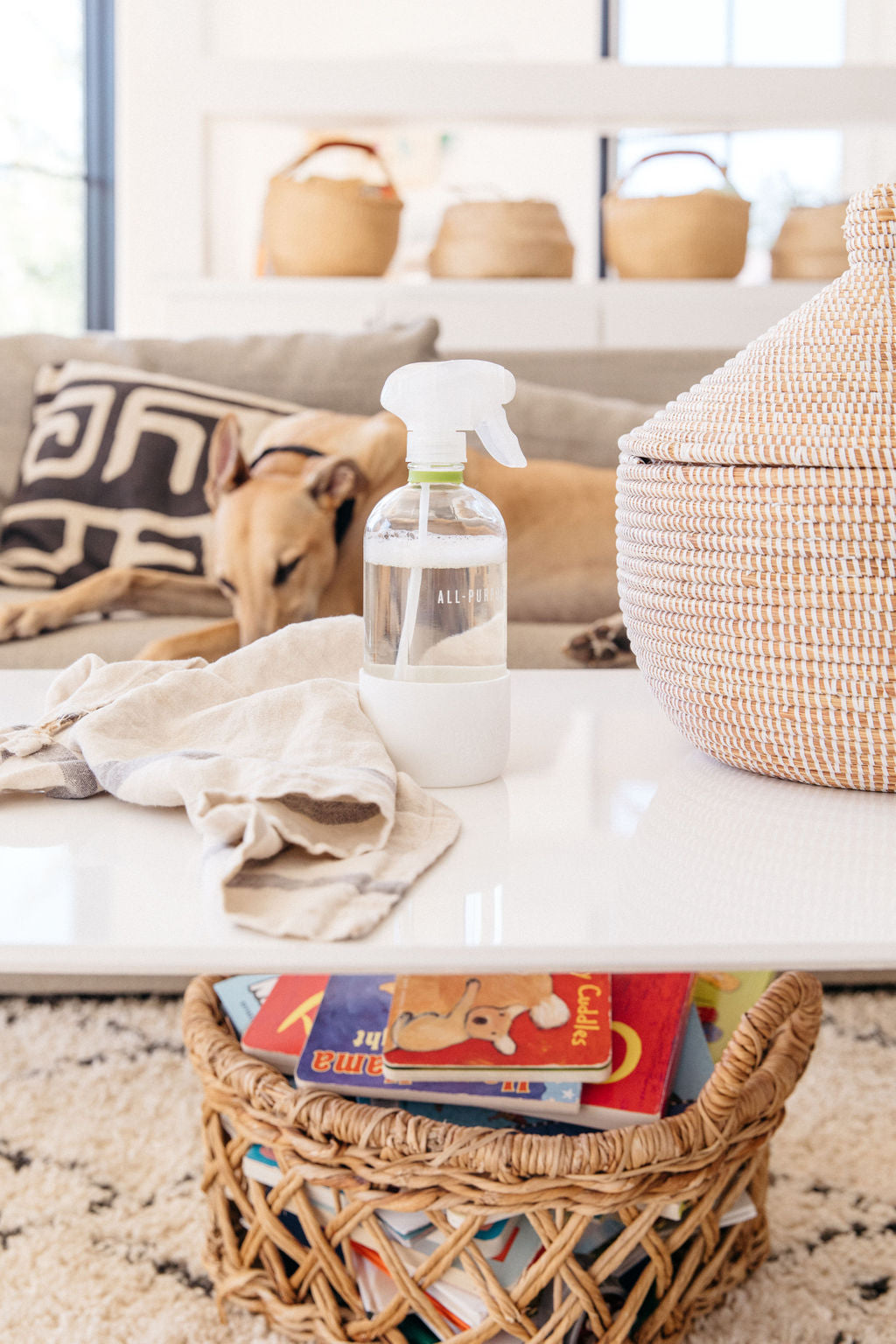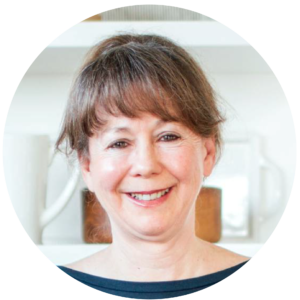How to Get Rid of House Dust Naturally

No matter how often you clean your home, dust will always be there. Floating in the air, or attached to household trinkets and surfaces, dust can be quite the household nuisance.
To the naked eye, dust presents itself as tiny harmless orbs floating about in the air. But look deeper, and you’ll find dust is actually a dirty cocktail of toxins, allergens, and contaminants.
When properly done, certain dusting techniques and tools can help you get rid of house dust naturally without the use of toxic chemicals. We’ll teach you how to remove it - and prevent it - safely and effectively.
Why It’s Important to Dust & Prevent Dust With Natural Solutions
Typically, dust is made up of biological contaminants such as dead skin cells, bugs, dust mites, bacteria, and dirt. But that’s not all. Dust also attracts harmful chemicals and toxins found in everyday household products, such as heavy metals, VOCs, and SVOCs.
These tiny dust particles fly around in indoor air and are easily inhaled—a major cause of many allergic and respiratory reactions. If not taken care of, dust eventually settles and builds up on furniture, floors, and porous ceilings and walls.
Household dust plays a role in children’s increased exposure to harmful chemicals, around 60mg of dust per day. Astonishing, and a good reason to grab a damp microfiber cloth and get to work.
Preventing and getting rid of house dust naturally is the key to improving indoor air quality and is beneficial to your health. With some diligence and consistency, dust won’t stand a chance when you implement these simple and natural dusting solutions.
Related Read: Why Household Dust Matters to Your Health
6 Natural Ways to Prevent Dust in Your Home
1. Opt for Microfiber Towels Instead of Dusters
Traditional feather and synthetic dusters lift dust and allergens but don’t trap them. Instead, they send dust back into the air to later settle on another surface. Whereas a lightly dampened microfiber towel with water or a natural dusting solution such as Streak-Free, is safe on most surfaces, and lifts and removes dust from your home.
Microfiber towels remove dust with an electric charge. The tiny fibers rub together to create a static electric charge (a positive charge), increasing its ability to find and grab dust. They remove up to 99% of dust and dirt on their own and are thought to be four times more effective than conventional cleaners.
These versatile, and reusable, cleaning tools are a must to have on hand.
2. Vacuum With a Sealed HEPA Filter Frequently
Dust and air pollutants don’t stand a chance against the power of a certified sealed HEPA vacuum. These air-tight, dust-busting machines remove 100% of air pollutants and contaminants found around the home.
Vacuum at least once a week. Clean carpets, rugs, curtains, furniture, and even lampshades. This is especially important for asthma and allergy sufferers, as vacuuming helps keep household allergens at bay.
3. Use Water or Natural Dusting Solutions
Damp dusting with water or a natural dusting solution such as Branch Basics Streak-Free, efficiently removes dust particles by the action of capillary force. In simpler terms, a damp microfiber cloth attracts and lifts dust particles from a surface, instead of just moving them around.
Sure, you could use a dry cloth, but this method doesn’t always wipe dust away. Instead, dry dusting only rearranges and smears dirt and debris around. Quite counterintuitive, as you’ll only find yourself dusting again days later.
So give damp dusting a try. Here’s how:
- Lightly dampen a microfiber cloth with water or Streak-Free, ringing it out until almost dry.
- Run the cloth over the dusty surface or item to loosen and capture dust and debris.
- When finished, rinse the cloth in warm water until clear of dust and dirt. Hang to dry.
Related Read: The Official Branch Basics Spring Cleaning Method
4. Choose a Healthy Air Purifier
A quick and effective way to reduce household dust is with a home air purifier. These powerhouse air filtration systems come in a variety of shapes and sizes, from small and portable to large whole-house options. Air purifiers have fans that circulate the air and a filter (ideally a HEPA filter) that captures dust and other pollutants in the air.
A quality air purifier should come equipped with a medical-grade HEPA filter, and be capable of removing:
- Volatile Organic Compounds (VOCs)
- Semi-volatile Organic Compounds (SVOCs)
- Biological Contaminants (this includes common household dust)
- Radon
- Asbestos and Lead
Shopping for an air purifier? Get all the details in How to Choose an Air Purifier for Your Home.
5. Clean Your House Plants
Houseplants improve the air quality in your home and provide a beautiful aesthetic to interior decoration. But because they sit stagnant around the house, plants often become a prime target for settling dust.
Give houseplants a gentle brush-off with a microfiber cloth every month. Keeping these natural air purifiers dust-free helps them maintain their ability to absorb sunlight.
6. Don’t Forget About Walls and Ceilings
If walls (and ceilings) could talk, they would beg for the removal of air pollutants and dust often trapped in porous drywall. Frequently dusting ceilings and walls removes contaminants, improving air quality in your home. Better air means a happier, healthier, more comfortable living space for all to enjoy.
How to dust walls and ceilings:
- Grab a ladder and take it one room at a time, working top to bottom.
- Using a HEPA vacuum’s soft brush attachment, vacuum ceilings and walls to loosen and remove dust.
- Damp wipe with a microfiber towel or unscented dry Swiffer and a safe cleaner like Branch Basics for a deeper clean.
For a more thorough clean, check out How to Clean Walls and Ceilings Using Branch Basics.
7. Groom Your Pets in a Separate Space
Regularly grooming your pets helps significantly reduce dirt, hair, and dead skin cells from accumulating around the house. Brushing indoors, however, stirs up hair, dust, and pet allergens which can cling to household items such as couches and rugs. Avoid common living spaces and carpeted rooms and opt instead for an easy-to-clean space.
To keep hair and allergens contained, choose a room with tile or hardwood floors, such as a bathroom. Remove any rugs, and upholstered furniture, and close all doors. After grooming is complete, vacuum the walls, baseboards, and floors.
8. Declutter Frequently
One of the most impactful things you can do to prevent dust is to keep your home tidy and free of clutter. It goes without saying that maximizing stuff maximizes dust, while minimizing stuff minimizes dust. Keep flat surfaces clear of trinkets, and choose to declutter items you no longer use.
Tips for decluttering your home:
- Only keep items that you know you’ll use.
- Throw away broken and unusable items. Be sure to recycle paper, glass, and plastic.
- Donate items you no longer use that are still in great shape.
- Store items you want to keep, but don’t have a place for right now.
Set a regular cleaning schedule and declutter frequently. By doing so, you’ll quickly notice a significant decrease in household dust.
9. Detoxify Your Clothing and Bedding (& Change Them Often)
The fabric fibers found in clothing and bed linens trap and (believe it or not) produce dust. Human skin cells, textile fibers, and the chemicals used to make these products are among the biggest household dust creators.
To help keep dust levels down, begin by detoxifying your clothing and bedding. New and used fabrics washed in conventional laundry products have chemical residues that are harmful to your health. Not to mention, many clothing and bedding companies use toxic chemicals during production, including:
- Formaldehyde is used in the textile industry. In some clothes it is used to keep clothes and fabrics wrinkle free. Refuse to buy clothes that have a wrinkle free/no-iron label.
- Phenols - used as an anti-microbial finish in clothing and bedding and can cause serious respiratory issues when inhaled.
- Organo Silver - used as an antimicrobial finish. Quote from this study showed - “These results are counterintuitive and surprising, since the primary reason for incorporating silver ions into garments is to manage or reduce the bacterial load and to control odor formation. This study shows the opposite outcome from the intended primary reason for including silver particles, as a higher bacterial load on skin was found, and particular malodor-associated taxa were increased on skin. Avoid all clothing or shoes claiming to be antibacterial or antimicrobial as they impact the microbiome of the skin.
- Perfluoroalkyl substances (PFAS) - a known carcinogen used in textiles to make them water, oil, and stain-resistant. Refuse to buy clothes treated with PFAS chemicals.
These highly toxic “forever chemicals” are bioavailable, and do not leave the body easily. PFAS chemicals are SVOCs which means they release into the air, riding on tiny dust particles infiltrating the air you breathe. To prevent this from happening, toss all clothes that are treated with PFAS chemicals.
Plan to wash sheets weekly in a fragrance-free, human-safe laundry detergent like Branch Basics. We also recommend washing comforters, blankets, throw pillows, and mattress pads every month.
Toss the Toxins With Branch Basics
Less household dust means better air quality and better air quality means a healthier home and family. Follow these tips to get rid of house dust naturally and you’ll be living dust-free for years to come.
To naturally remove and prevent household dust, incorporate Branch Basics products into your home dusting schedule. To get started, try the Branch Basics Premium Starter Kit.

Marilee Nelson
Marilee Nelson is an Environmental Toxins expert who has spent nearly 30 years advocating for the chemically-sensitive and chronically-ill. She is a Board Certified Nutritionist, Certified Bau-Biologist and Bau-Biology Inspector and specializes in Food As Medicine. She has helped thousands of families and individuals identify, heal and recover from toxic exposures and is on a mission to revolutionize the way American families view their health.








